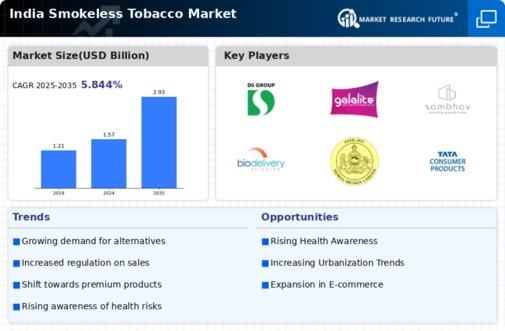Diverse Product Offerings
The smokeless tobacco market in India is characterized by a wide array of product offerings, catering to diverse consumer preferences. From flavored varieties to different forms such as snuff and chewable tobacco, the market provides options that appeal to various age groups and tastes. This diversity not only attracts new consumers but also retains existing ones, as individuals seek products that align with their preferences. The introduction of innovative flavors and packaging has the potential to further enhance market growth. As competition intensifies, companies are likely to invest in product development, which could lead to an expansion of the smokeless tobacco market.
Rural Consumption Patterns
Rural areas in India represent a significant segment of the smokeless tobacco market, where traditional consumption habits are prevalent. The smokeless tobacco market thrives in these regions due to the established cultural practices and the lack of stringent regulations compared to urban areas. Approximately 70% of smokeless tobacco users reside in rural settings, indicating a strong reliance on these products. The market's growth in rural India is likely to continue as local manufacturers cater to the specific needs and preferences of these consumers. This rural focus may also influence marketing strategies, emphasizing community engagement and traditional values.
Economic Accessibility and Affordability
Economic factors play a crucial role in shaping the smokeless tobacco market in India. The affordability of smokeless tobacco products compared to other tobacco forms makes them accessible to a broader demographic. With prices often ranging from ₹5 to ₹20 per packet, these products cater to low and middle-income consumers, thereby sustaining high consumption rates. The smokeless tobacco market is projected to grow at a CAGR of 5% over the next few years, driven by this economic accessibility. As disposable incomes rise, the market may witness an increase in premium product offerings, yet the core affordability will likely remain a significant driver for continued consumption.
Influence of Peer Groups and Social Norms
Social dynamics play a pivotal role in the smokeless tobacco market in India. Peer influence and social acceptance significantly impact consumption patterns, particularly among younger demographics. The smokeless tobacco market benefits from a network effect, where individuals are more likely to try these products if they observe their peers using them. This social aspect is further reinforced by marketing strategies that target group consumption scenarios. As societal norms evolve, the smokeless tobacco market may experience shifts in consumer behavior, potentially leading to increased usage among new demographics. Understanding these social influences is essential for stakeholders aiming to navigate the complexities of the market.
Cultural Significance of Smokeless Tobacco
The smokeless tobacco market in India is deeply intertwined with cultural practices and traditions. Various regions have unique forms of smokeless tobacco, such as khaini and gutkha, which are often consumed during social gatherings and rituals. This cultural significance drives demand, as these products are not merely viewed as alternatives to smoking but as integral components of local customs. The market is estimated to be valued at approximately $2 billion, reflecting the strong consumer base that continues to support these traditional products. The enduring popularity of smokeless tobacco in India suggests that cultural factors will remain a key driver in the smokeless tobacco market, influencing consumption patterns and product innovation.


















Leave a Comment